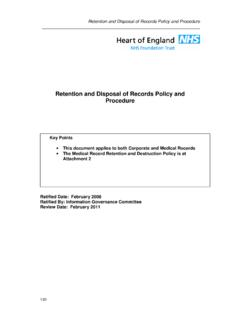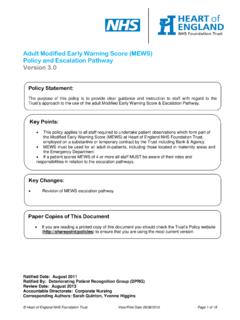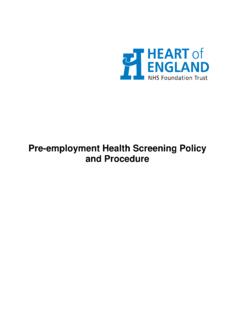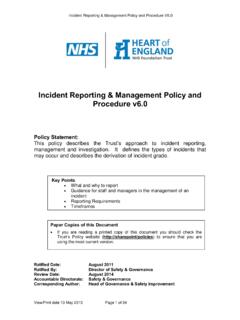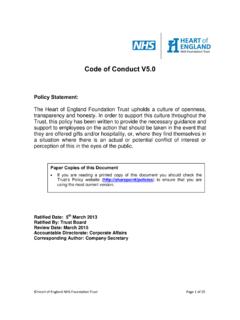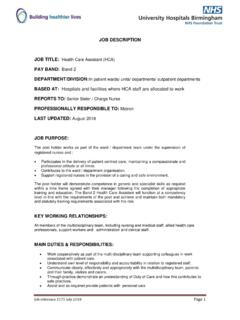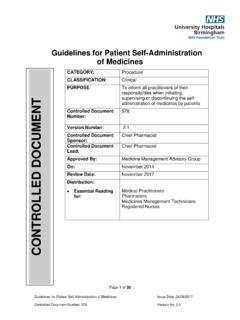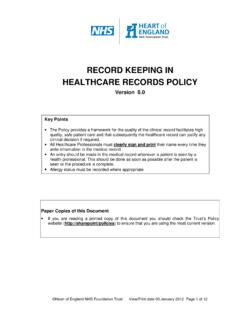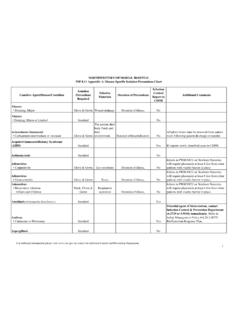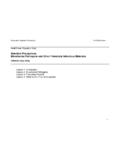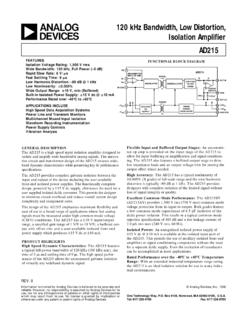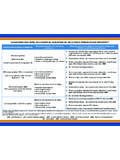Transcription of Isolation Policy - hgs.uhb.nhs.uk
1 Isolation Policy The term Isolation is the use of infection prevention and control precautions aimed at controlling and preventing the spread of infection. There are two types of Isolation Source Isolation (barrier nursing) where the patient is the source of infection and Protective Isolation (reverse barrier nursing) where the patient requires protection they are immunocompromised. Ratified Date: March 2010 Ratified By: Infection Control Executive Committee Review Date: March 2012 Corresponding Author: Infection Prevention and Control Team Heart of England NHS Foundation Trust Isolation Policy 1 Contents Meta Data 1. Summary 3 2.
2 Introduction 3 3. General Principles 4 Source Isolation 4 Criteria for Source Isolation 5 4. Risk Assessment 6 . 5. Effective Communication 6 6. Procedure for Source Isolation 7 7. Curtains 18 8 Patient Clothing and Soiled Laundry 18 9. Protective Isolation 18 . 10. Responsibilities 19 11. Monitoring Arrangements 22 12. References 23 Appendix 1 Daily procedures for cleaning an Isolation room or a bed space of an infected patient Appendix 2 Procedure for the Terminal Clean of a Vacated Room following the discharge charge of all patients that have been source isolated Appendix 3 Alert Organism Risk Assessment for the Use of Isolation Rooms Appendix 4 Equality and Diversity - Policy Screening Checklist Appendix 5 Approval/Ratification Checklist Appendix 6 Launch and Implementation Plan Heart of England NHS Foundation Trust Isolation Policy 2 Meta Data Document Title: Isolation Policy Status Active.
3 The approved and current version Document Author: Infection Prevention and Control Team Date Of Release: March 2010 Approved by: Infection Control Executive Committee Review Date: March 2012 Related documents Superseded documents Original Policy : 2000 1st Revision: 2003 2nd Revision: 2005 3rd Revision: 2008 4th Revision 2010 Relevant External Standards/ Legislation Key Words Source Isolation Barrier nursing Protected Isolation Reverse barrier nursing Immunocompromised Meticillin Resistant Staphylococcus aureus (MRSA) Viral diarrhoea and vomiting Other multi resistant organisms H1N1 Flu Cohort Heart of England NHS Foundation Trust Isolation Policy 3 1. Summary Prevention This Policy is intended to provide some general principles of Isolation precautions , when they may be required and the rationale behind their use.
4 Isolation precautions should be used for patients who are either known or suspected to have an infectious disease, are carrying a multi-resistant organism or are particularly vulnerable to infection. It is important however, that staff ensure that standard Infection Prevention control precautions are used for all patients regardless of their status. These include the use of gloves, aprons, masks and visors following a risk assessment to identify the risks of exposure to blood, body fluids and micro-organisms. Further guidance can be obtained from the Trust Standard precautions Policy . The Trust Infection Prevention and Control policies must be used in conjunction with this advice.
5 These include: Standard precautions Policy Hand Decontamination Policy Laundry Policy Sharps Policy Decontamination Policy Cleaning, disinfection and sterilisation of medical equipment and the environment W aste Management Policy Outbreak of Infection Policy Influenza Policy Tuberculosis Policy 2. Introduction The term Isolation is the use of Infection Prevention and Control precautions aimed at controlling and preventing the spread of infection. There are two types of Isolation Source Isolation (barrier nursing) where the patient is the source of infection and Protective Isolation (reverse barrier nursing) where the patient requires protection they are immunocompromised.
6 Heart of England NHS Foundation Trust Isolation Policy 4 3. General Principles Source Isolation Source Isolation is designed to prevent the spread of pathogens from an infected patient to other patients, hospital personnel and visitors. This has previously been known as barrier nursing. The need for Isolation is determined by the way the organism or disease is transmitted. Source Isolation can be achieved by placing patients in: Single rooms on general ward Isolation units with Isolation rooms with negative pressure ventilation with an anteroom and ensuite facilities. Examples of organisms requiring source Isolation may include: Pulmonary Tuberculosis Chickenpox Extended Spectrum Beta Lactamase (ESBL) producing coliforms Meticillin Resistant Staphylococcus aureus (MRSA) Viral diarrhoea and vomiting Other multi resistant organisms H1N1 influenza When single rooms or Isolation rooms are not available and where several patients with the same confirmed organism have been identified these patients may be nursed together in a bay or ward.
7 This is called Cohort nursing. Examples may include diarrhoea and vomiting, Clostridium difficile diarrhoea, norovirus and influenza. This will be done with the advice of a member of the IPCT. At Heartlands Hospital ward 27 is used for the cohorting of patients with Clostridium difficle diarrhoea. Patients from Solihull and Good Hope will also be cohorted to this ward. Certain specific organisms will require negative pressure side rooms or specialised care from the Infectious Disease Unit (W ards 28) Drug resistant pulmonary tuberculosis. Other patients may be nursed in single side rooms on general wards. Occasionally it may be necessary to nurse these patients within a main bay (only following Heart of England NHS Foundation Trust Isolation Policy 5 discussion with the Infection Prevention Control team) when the use of a side room would be detrimental to the patient s clinical condition.
8 It is acknowledged that there are constraints to placing every patient who is either colonised with a pathogen or who is showing clinical signs of transmissible disease into a side room. However, a Risk Assessment must be carried out, in conjunction with the Infection Prevention and Control Team (see Section 4 below). Where a patient is isolated within a main bay, the appropriate information relating to the risk assessment must be documented in the patients notes. An ongoing daily review must be undertaken by the Nurse in Charge to ensure that the side rooms are being utilised appropriately and to prevent patients remaining in Isolation unnecessarily Clostridium difficile patient who has had no further diarrhoea for 48 hours etc.
9 Criteria for Source Isolation Patients admitted with the following symptoms must be isolated on admission Known or suspected communicable infection /disease Pulmonary Tuberculosis, Chicken Pox Unexplained rash if considered to be of an infectious cause Multi-Resistant organism s MRSA, ESBL producing coliforms Multi resistant Acinetobacter baumannii (MRAB) Diarrhoea and/or vomiting until microbiologically proven negative or symptoms subside. Clostridium difficile Symptomatic of influenza If this is not possible because the patient would be at a greater risk by being isolated please contact the Infection Prevention and Control Team for further advice.
10 The following are examples of common organisms or conditions requiring source Isolation . This is not a comprehensive list and advice should be sought from the Infection Prevention and Control team if in doubt. Heart of England NHS Foundation Trust Isolation Policy 6 Mode of Spread Example Conditions Example pathogen Contact Diarrhoea, Infectious rashes, antibiotic resistant organisms, skin and soft tissue infections Clostridium difficile, Escherichia coli 0157, Staphylococcus Aureus including Methicillin resistant strains, Viral Diarrhoea and Vomiting (Can also spread by aerosol s), Streptococcus A, (until 48 hours of antibiotics) Droplet Meningitis, infectious rashes, respiratory tract infections Respiratory Syncytial virus Haemophilus Influenza, Influenza virus, Mumps, Rubella virus Airborne Infectious rashes, respiratory tract infections Varicella virus (chicken pox)
